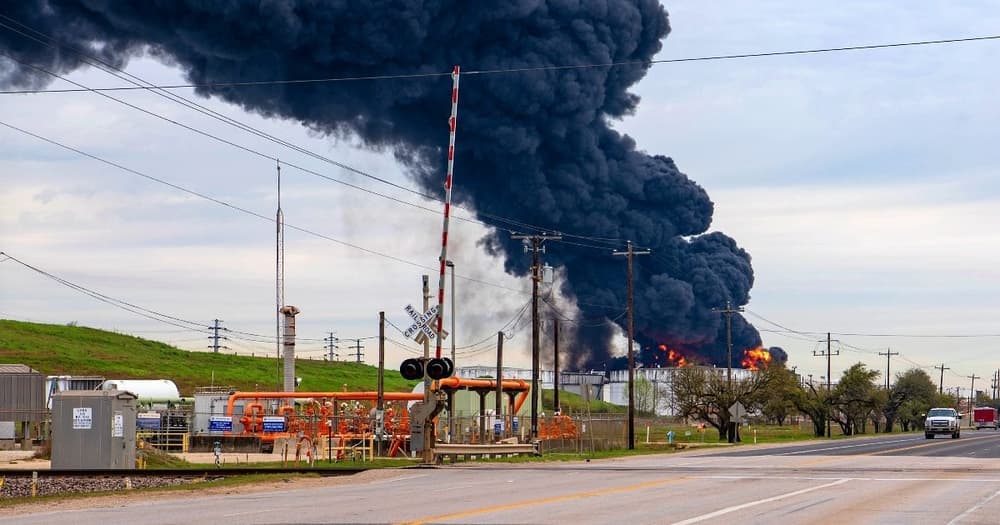Oil and gas is a widespread and lucrative industry but it is not without its safety risks.
However, health and safety measures have come a long way over the decades, creating safer work environments for oil and gas workers.
Yet the safety of a rig depends entirely on how closely these measures are followed. Recent disasters have proven that not following safety protocols can lead to deadly results.
Keep reading to find out more about the 7 biggest accidents in the history of the oil and gas industry:
1. C.P. Baker Drilling Barge - June 30, 1964
In June of 1964, in the Gulf of Mexico, the C.P. Baker drilling barge suffered a hull blowout that caused water to enter the barge and spread throughout the vessel through the main deck doors - which were left open.
This resulted in a complete loss of power and eventually an explosion that engulfed the barge in flames.
Around half of the crew survived the disaster by abandoning ship and jumping into the sea. The rest, unfortunately, were either confirmed dead or presumed dead.
2. Santa Barbara Oil Spill - January 28, 1969
Union Oil began drilling a fifth oil well in January of 1969 off the coast of Santa Barbara when the well blew. The explosion cracked the seafloor and released over 1000 gallons in an hour, causing it to spew oil and gas.
Another blowout followed in February of that year.
In the end, the California coastline was affected by 3 million gallons of crude oil. Until 1989, this was the largest oil spill in history.
The resulting destruction led to the creation of the National Environmental Policy Act and the next year the United States began to celebrate Earth Day.
3. Bohai 2 Oil Rig - November 25th, 1979
Operating in the Gulf of Bohai, located between China and Korea, the oldest Chinese-owned oil rig in operation flooded and capsized on November 25th, 1979.
It was being towed and was hit by a storm in which high winds broke the ventilator pump and punched a large hole on the deck. The rig filled with water and capsized.
The crew onboard did not have proper emergency evacuation training and a nearby boat could only rescue 4 of the 76 workers. Unfortunately, deck equipment had not been properly stored beforehand - if it had of, more workers could have survived.
4. Piper Alpha Platform - July 6, 1988
Perhaps one of the biggest disasters in the oil and gas industry is the accident involving the Piper Alpha platform on July 6th, 1988. Of the 226 people on board, 167 perished.
The platform was operating off the coast of the United Kingdom in the North Sea but a communication error led to the disaster. That morning, a pump was placed off limits due to the removal of a safety valve. Unfortunately, this information was not shared with the shift managers who went ahead and turned on the pump.
This action led to a continuous gas leak and fire which completely destroyed the Piper Alpha platform. The crew had not been properly trained in how to deal with a fire and the resulting panic cost so many lives.
4. Exxon Valdez Oil Spill - March 24, 1989
On March 24 of 1989, the oil tanker Exxon Valdez was heading for Long Beach, California when it struck a reef west of Alaska and spilled 10.8 million gallons of crude oil over the course of a few days.
In terms of damage to the environment, this is considered to be the worst oil spill in the world. The location of the spill was only accessible by boat, plan and helicopter so cleanup response was difficult.
5. Usamacinta Jack-Up - October 23, 2007
On October 23rd, 2007, the Usamacinta jack-up platform collided with another platform in the Gulf of Mexico. The other platform hit the production tree of the Usamacinta during a storm and caused oil and gas to leak into the sea.
The crew of the Usamacinta attempted to close the safety valves but were unable to do so. The leaked oil and gas led to a fire on the platform in which 21 people died and one one other worker was presumed dead.
6. The Deepwater Horizon - April 20, 2010
The Deepwater Horizon, an oil rig owned by Transocean, caught fire and exploded on April 20th, 2010, off the coast of Louisiana. There are were many red flags leading up to this disaster.
The previous year, there were concerns that the materials used by the Deepwater Horizon for drilling may buckle under pressure - but the workers who noticed this feared that they would be fired for raising this concern. In March of 2020, damage to the blowout preventer went unreported.
The Deepwater Horizon burned for over a day before eventually sinking. Of the 126 workers onboard the rig, 11 died and 17 were transported to hospital. Other workers were taken to a hotel and forced to sign a waiver claiming that they were not injured.
The Importance of Safety in the Oil and Gas Industry
It goes without saying that following safety regulations and protocols in imperative to prevent such disasters from happening in the oil and gas industry.
If you are an oil worker, and have concerns regarding the safety of equipment and the crew, do not hesitate to report your findings and have the situations corrected.

